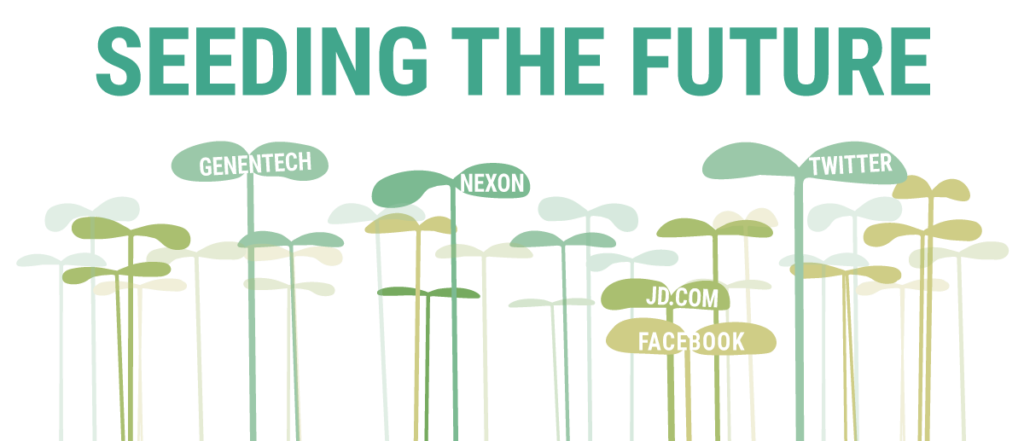Seeding the Future: The Big Picture on Seed and Pre-Seed Investing

Our “Seeding the Future” series explores trends, opportunities, and companies from the seed and pre-seed venture world. This is the investment focus of AVG’s newest Basecamp Fund.

The fund is now open! Click below to learn more.
Investing in seed and pre-seed deals is your greatest opportunity for outsized returns as well as for making a difference. It’s also the venture stage that offers the lowest minimums and highest risk. In fact, it’s the risk factor that concerns many would-be seed investors. But learning more about this stage of investing can shine a light on these opportunities and help you determine whether it’s a potential add to your portfolio.
Key Facts About Seed and Pre-Seed Investing
- Many opportunities—but access to top seed deals is very competitive. According to Crunchbase, over 20,000 seed and pre-seed raises occurred in 2019, with nearly $16B invested. Access to top seed deals is increasingly competitive as the seed investing space matures.
- More maturity. Early startups might have more history behind them than you expect. The average company raising a seed round has been in business over 3 years (according to Natalie Dillon of Susa Ventures). And 2/3 of companies closing a seed round in 2019 were generating revenue — a dramatic rise from only 9% in 2010. These “delayed” raises are due to cheaper technology, the spread of accelerators/incubators, and the ability to hire relatively inexpensive freelancers.
- Advantages to getting in early. Only about 1% of seed deals will become a unicorn. And a lot of critical growth happens at the seed stage, as noted from this study of thousands of VC deals, “Seed-stage returns tend to be more extreme than later rounds for two reasons: Startups tend to grow faster earlier, and seed investments have longer to compound these higher growth rates.”
Bottom line, there are more seed and pre-seed deals, getting in the best ones is hard, and you’ll need to make a lot of investments to snag the difference-makers.
Seed Investing During “Crazy Times”
The pandemic has impacted seed investments, though less than you might imagine. Some sources report that deal volume and dollars raised have dropped since Spring 2020. But note that in the last recession, the number of deals for angels and seed investors actually rose over time, though capital commitments did decrease.
In addition, stronger startups survive and can even demand higher valuations. Note these unicorns were born during the last recession.
2008
- Airbnb (private; $38B, 2019)
- Pinterest (public; $14B, Oct 2019)
- Cloudera (public; $2.5B, Oct 2019)
- Beats (acquired by Apple for $3B in May 2014)
- Yammer (acquired by Microsoft for $1.2B in July 2012)
2009
- Uber (public; $54.6B, Oct 2019)
- Square (public; $26.9B, Oct 2019)
- Slack (public; $12.5B, Oct 2019)
- Nutanix (public; $4.9B, Oct 2019)
How to Sow Your Seeds
So what are some keys to investing at the seed stage?
- Invest in a lot of deals. Venture is a power law asset (most of the winnings derive from a few out of many investments). And when it comes to seed, a Kauffman Fellows report noted: “Performance generally increases in the number of investments made…suggesting that the typical investor with a 100-investment portfolio outperforms the typical investor with a single investment by almost 9% a year.”
- Co-invest with established seed investors and syndicates. Being linked with or backed by experienced seed investors or accelerators can boost a startup’s prospects. Y Combinator startups, for example, are 3x more likely to become unicorns.
- Diversify across region and sector. Diversification helps spread risks and minimize chances for losses. Investing in other regions can also give you access to opportunities at lower valuations.
- Save dry powder for your winners. The mortality rate is high in startups, and it makes sense to reserve follow-on money to support winners.
- Recognize that seed is in a class by itself. As David Hornik, a general partner at August Capital, remarked, “At the end of the day, seed investing is very different from series A investing, and it is very different from late stage investing — they take different disciplines.”
These are the principles that AVG’s Basecamp Fund abides by. We create a portfolio of ~100 deals, co-investing with established leads, diversifying investments, reserving ~25% for follow-ons, and dedicating a team of 8 professionals to investing your portfolio.

AVG’s Basecamp Fund offers investors a portfolio of ~100 pre-seed and seed investments diversified across sector and region. Approximately 25% of the fund is reserved for follow-on investments. Minimum starts at $25K. The fund is now open! Click below to learn more.
Contact [email protected] for additional information. To see additional risk factors and investment considerations, visit av-funds.com/disclosures.